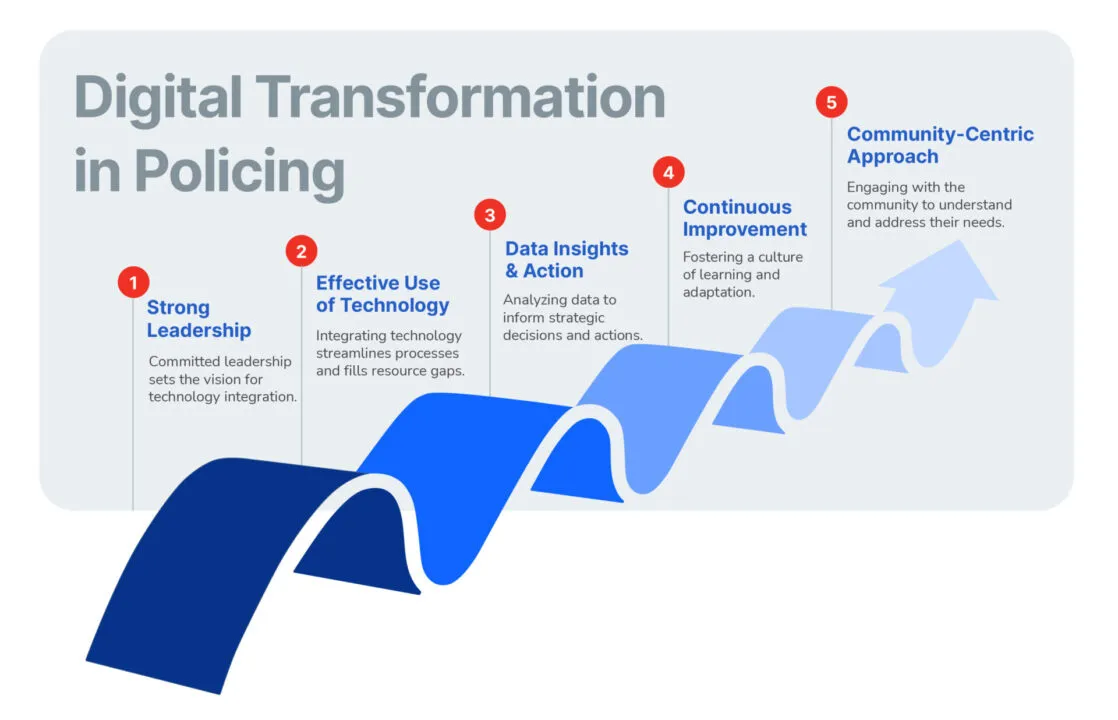Before focusing my professional career on digital transformation in policing, I worked in management consulting, partnering with large commercial companies as they navigated their digital transformation journeys. These efforts spanned various stages as companies sought to change through the adoption of new technologies that would enable them to be more efficient, effective, and responsive to their customers’ needs. Each of these companies worked to determine how to grow their businesses and do more for their customers with fewer resources, ultimately seeking a greater return on this investment.
The law-enforcement industry is no different. At SoundThinking, I’ve met with numerous policing agencies across the country, and I have yet to find an agency that is fully staffed with the required number of sworn officers. As agencies grapple with the demands of public safety, they, like many private organizations, are asked to do more with less. As a result, there’s unprecedented demand for the ability to harness technology and data to meet public safety needs. Technology is a force multiplier that agencies should consider to help address the complex challenges they face.
Understanding Today’s Digital Transformation in Policing
Embarking on a digital transformation journey in policing can be a lengthy and challenging process. However, key ingredients to driving such a transformation start with five key pillars.

Pillar # 1: Strong Leadership
Digital transformation starts and stops with strong, committed leadership. The leadership team needs to have a clear vision for how a policing agency can effectively leverage technology and data insights as a force multiplier.
Take the City of Boston, for example. Despite facing pushback over the continued use of ShotSpotter, Mayor Michelle Wu has remained a firm advocate, highlighting its role in saving lives by enabling faster police responses to shootings. Boston Police Commissioner Michael Cox also supports the system, stating that it’s been crucial for timely responses to shootings, especially those that might not be reported through traditional means. Ultimately, leadership’s backing of public safety technology sends a strong message to both law enforcement and the community, promoting public safety while helping police departments maximize their limited resources.
East Chicago also serves as a testament to the power of strong leadership. Like many urban areas, East Chicago law enforcement faced challenges in efficiently allocating police resources to address high-crime areas, especially with the reduced staffing numbers. Seeking a data-driven solution to improve public safety, law enforcement leadership deployed ResourceRouter in 2023. Since implementing the patrol management software, East Chicago has seen a marked improvement in crime reduction efforts, with a 55% decrease in homicides in 2023 compared to 2022.
Pillar # 2: The Effective Use of Technology
The integration of key technology solutions can streamline processes and fill gaps that have been left unattended due to limited resources. Driving this change will be challenging and will require consistent advocacy from the top and among key champions within the agency. Inevitably, there will be hesitation, a fear of doing things differently, and calls for “just doing good old-fashioned policing.”
But how can policing practices remain the same in an ever-changing and complex community environment? The use of technology in 2025 should be an expectation. Today, many agencies utilize cameras, license plate readers, gunshot detection capabilities, drones, and other digital technologies to provide insights and share data that complement human efforts. For example, ShotSpotter’s gunshot detection technology provides insight into incidents where there are no 9-1-1 calls for service. Research from the Brookings Institute indicates that 80% of gunfire is never called in to the police. How can police effectively support public safety objectives when they are only aware of a small percentage of the ongoing illegal activity? In this context, technology is quite literally saving lives.
With that said, continual evaluation of all law enforcement technology is essential to ensure it delivers maximum value and addresses operational needs and gaps.
Albuquerque stands out as a city that continually assesses its technology and proactively implements measures to maximize its efficacy. In partnership with investigators at the Crime Lab and the Real Time Crime Center, the Albuquerque Police Department (APD) launched a pilot initiative called the ShotSpotter Hotspot Organized Tracking program. The goal was to proactively address gun violence in a Southeast Albuquerque neighborhood with a high number of ShotSpotter gunshot detections. Since the program launched, which has become a collaborative effort with members of the community, there has been a reported 47% decrease in gunshot detections in the Southeast neighborhood.
Pillar # 3: Turning Data into Insights and Action
One of the most valuable byproducts of digital technology is the data generated. Initially, this information may be difficult to analyze and determine how to turn into action. However, examining data from an aggregate view and evaluating trends will enable agencies to identify emerging patterns that can effectively inform strategies to mitigate and address violence and high-crime areas. The use of this aggregated data enables policing agencies to be more focused and strategic in deploying assets or resources to meet the evolving and growing public safety needs. Said another way, digital technologies provide insights that officers or teams may not see from their individual eyes. Finally, agencies will also need to invest in the skills and tools to help analyze this valuable information.
For a strong example of an organization that has leveraged data to turn insights into action, consider the Walking One Stop initiative. A cohesive multi-agency partnership that began in Miami-Dade in 2008, Walking One Stop reviews ShotSpotter data to identify communities that have recently experienced gunfire, bringing social and economic resources directly to the doorsteps of residents who need them most. To date, nearly 300 Walking One Stops have been completed, resulting in a positive, tangible impact for the communities where they’ve been implemented, including increased job placement, reductions in violent crime, and tips leading to the arrests of violent offenders.
Pillar # 4: Creating a Culture of Continuous Improvement
The fourth ingredient of success is cultural transformation. Leaders must create an environment of continuous improvement. When any organization changes, it’s essential to reward positive activities and behaviors, and to learn from those that have been less successful. The transformation journey is not a straight line. Asking key questions like “What can we do differently?” and “How do we continue to drive buy-in?” are fundamental to long-term success. Building a culture of continuous improvement will enable the agency to effectively leverage technology and underlying data, avoiding the “business as usual” mentality.
East Palo Alto exemplifies this culture of continuous improvement. Once considered the “murder capital” of the United States, the East Palo Alto Police Department, leveraging technology and police-community partnerships, was proud to report zero reported homicides for the year of 2023.
Pillar # 5: Community-Centric Approach
Finally, in any business it is important to understand your customer and their specific needs. Companies that provide products and features that meet their customers’ needs thrive and grow. Those that are not aligned with changing customer demands fail. From a policing perspective, agencies need to engage with community members to understand their public safety priorities and to build a relationship of trust. This valuable perspective will enable agencies to responsibly leverage technology and data in support of community-backed public safety objectives. Additionally, this will help establish solid, long-lasting partnerships with communities and community organizations.
The City of Springfield stands out as a shining example of a city that puts their community first Focused on facilitating a comprehensive approach to violence prevention by pooling resources and expertise, their Data for Good initiative and associated events have been involved in cleaning 55+ blocks, conducting door-to-door outreach with 85+ residents, and engaging 35+ local and national organizations to address residential needs. Learn more here.
Conclusion
I have observed that these five pillars are the key to success, whether in the public or private sector. The work involved to accomplish each of these objectives may be challenging, but staying the course will enable success. It is important for leadership and key sponsors to drive this chain of adoption, which in turn becomes a change in culture that can create lasting and beneficial public safety results for our communities.



